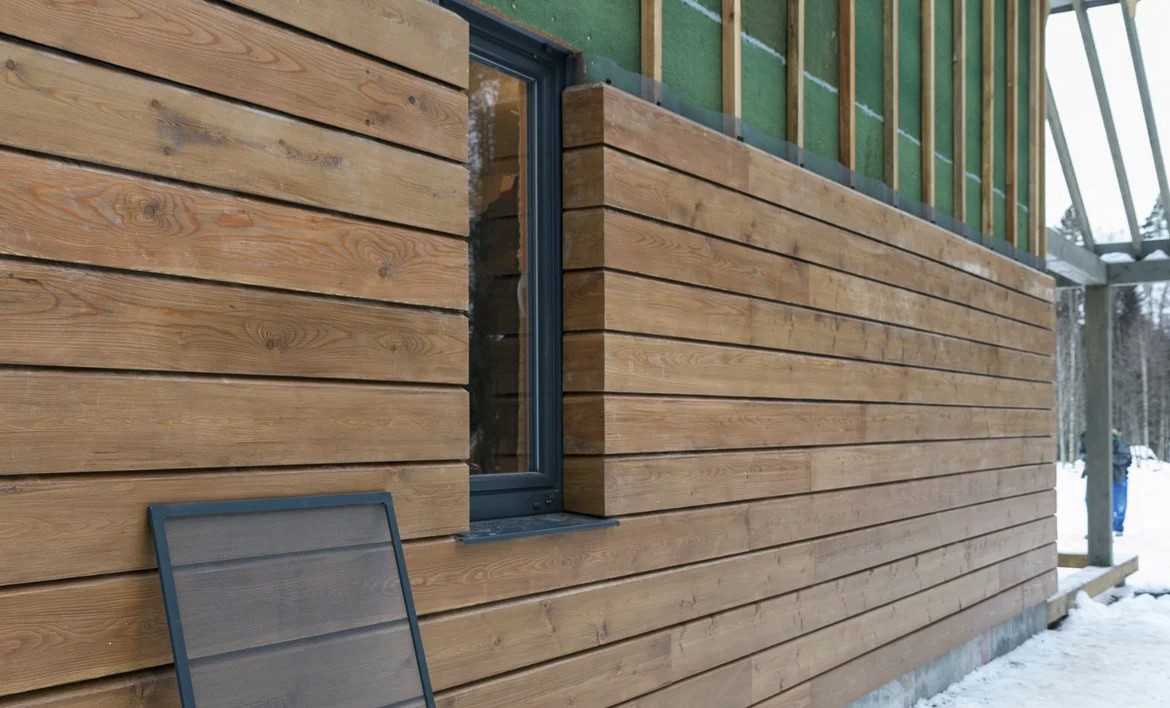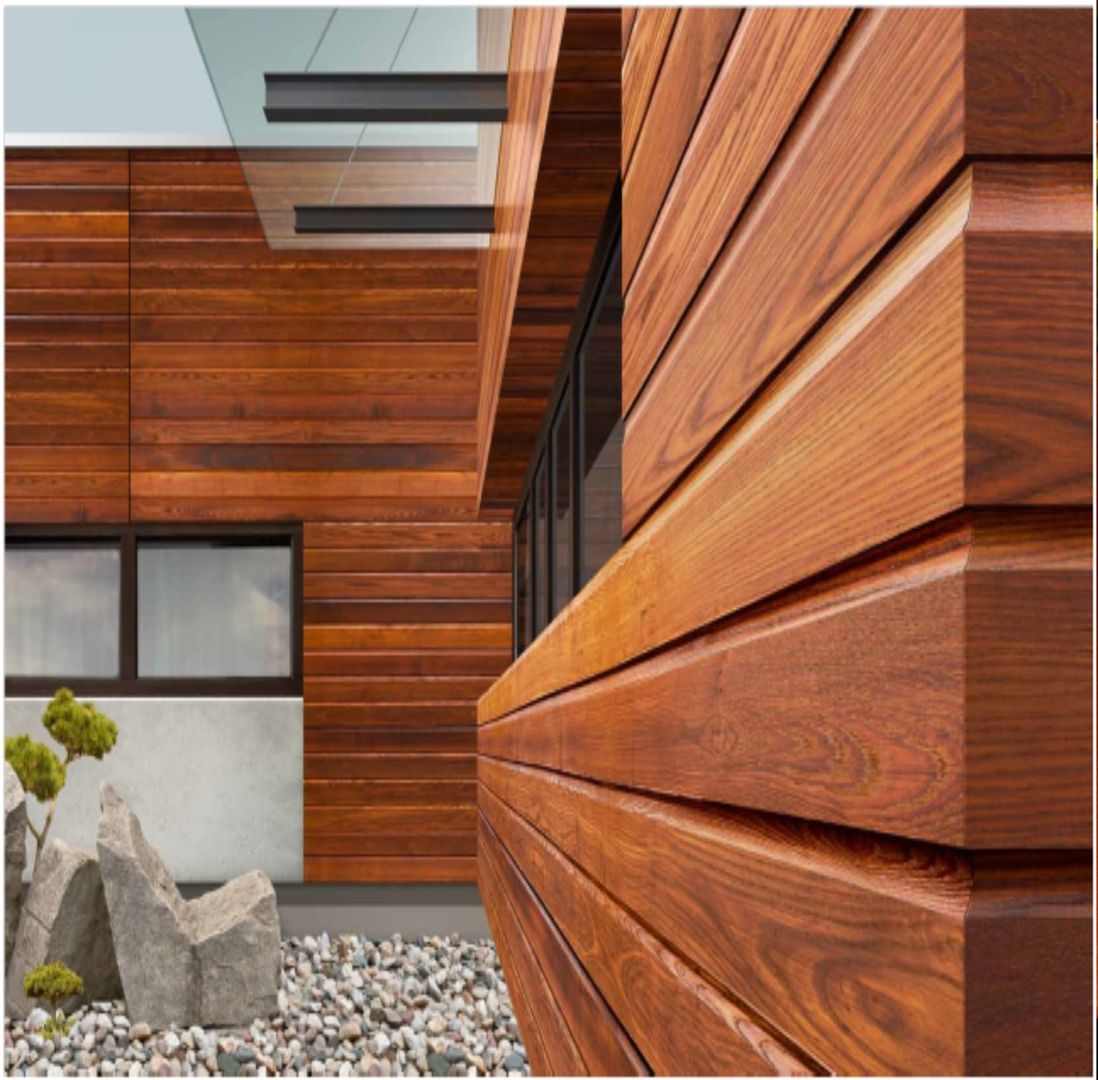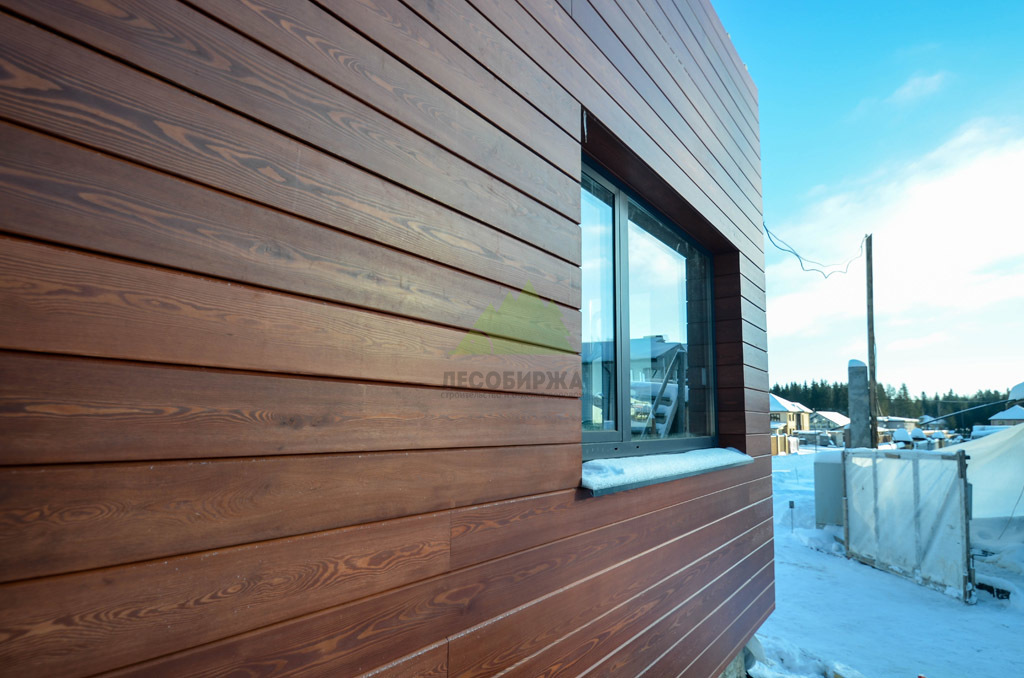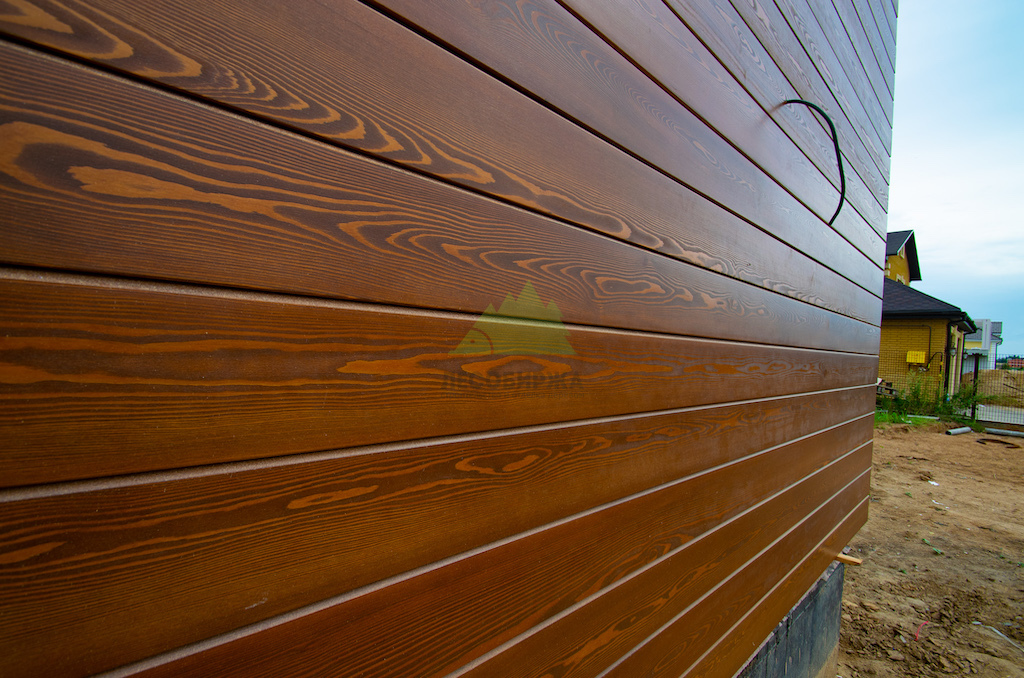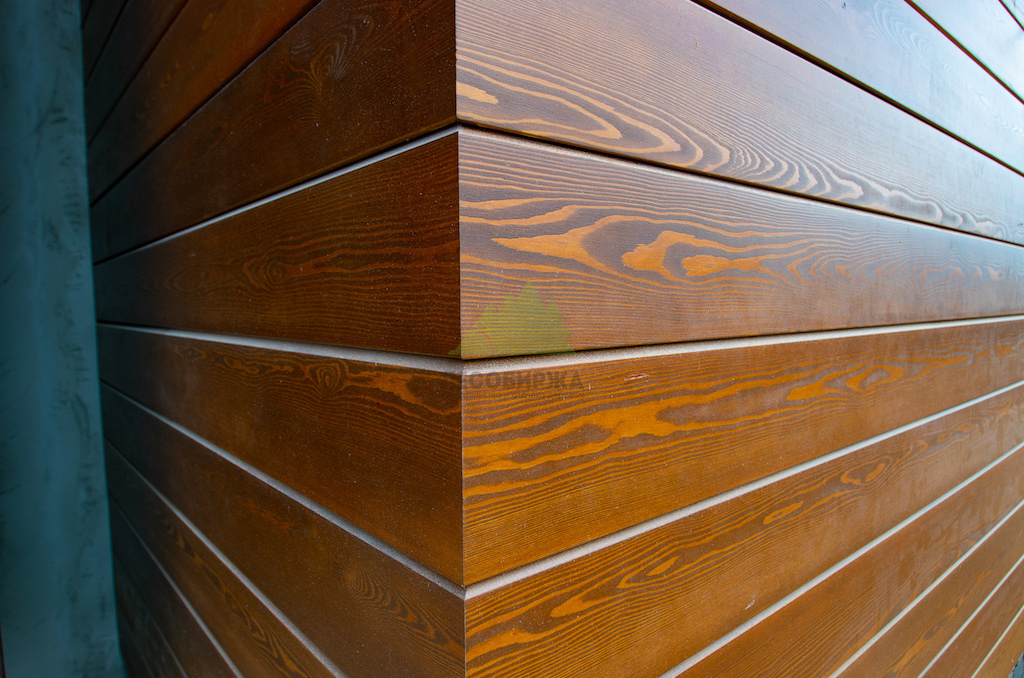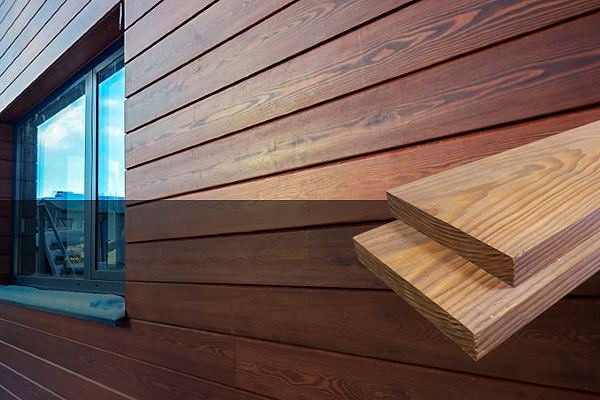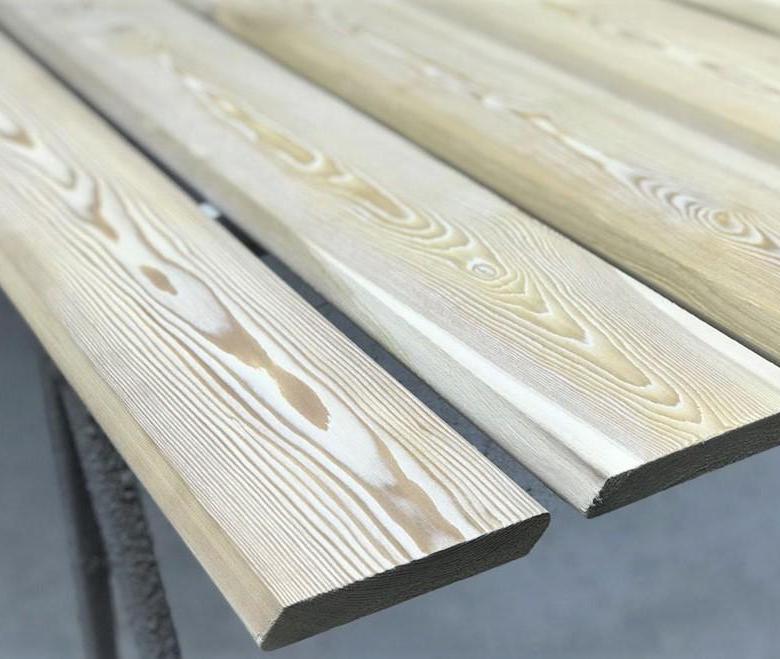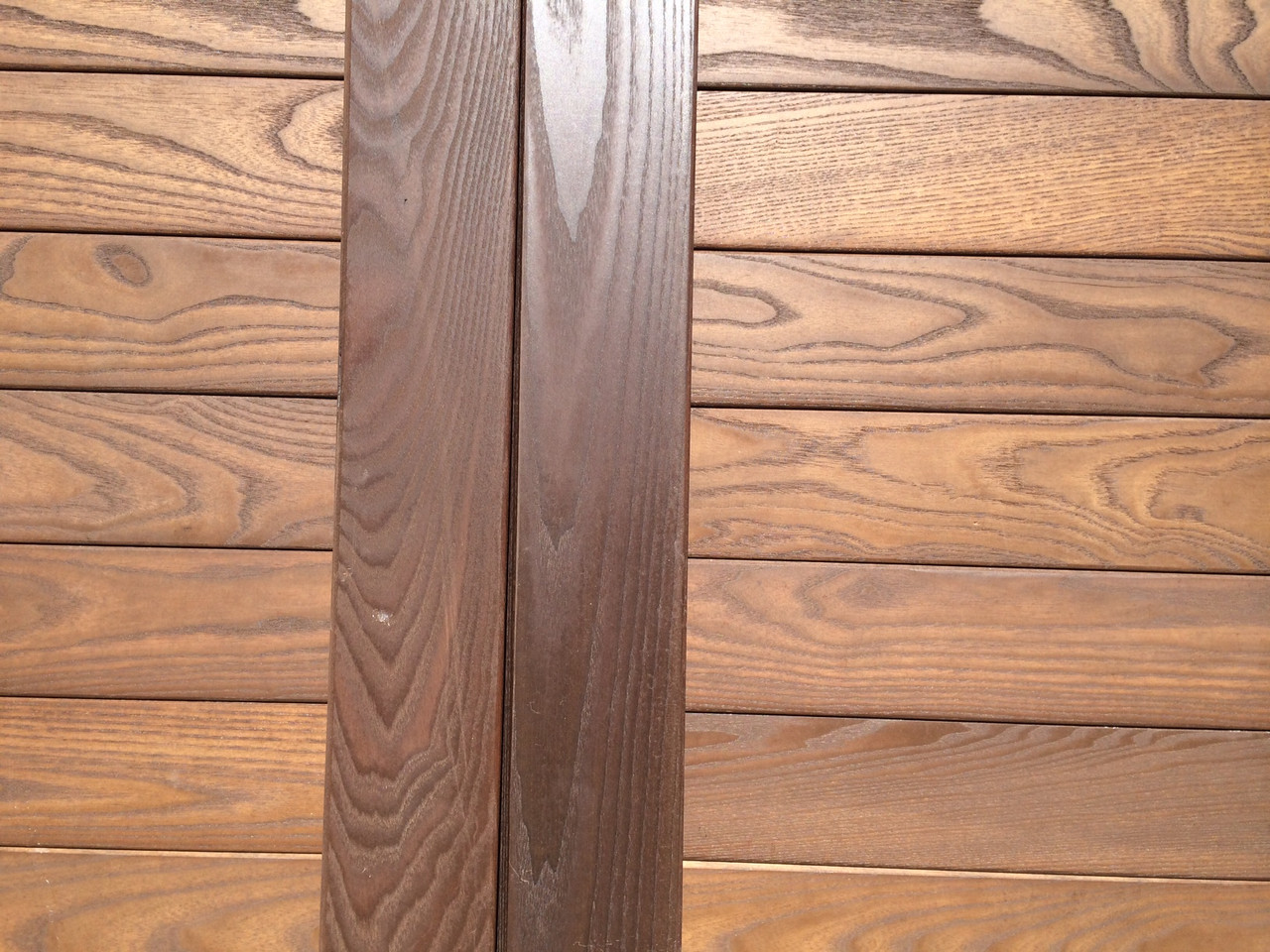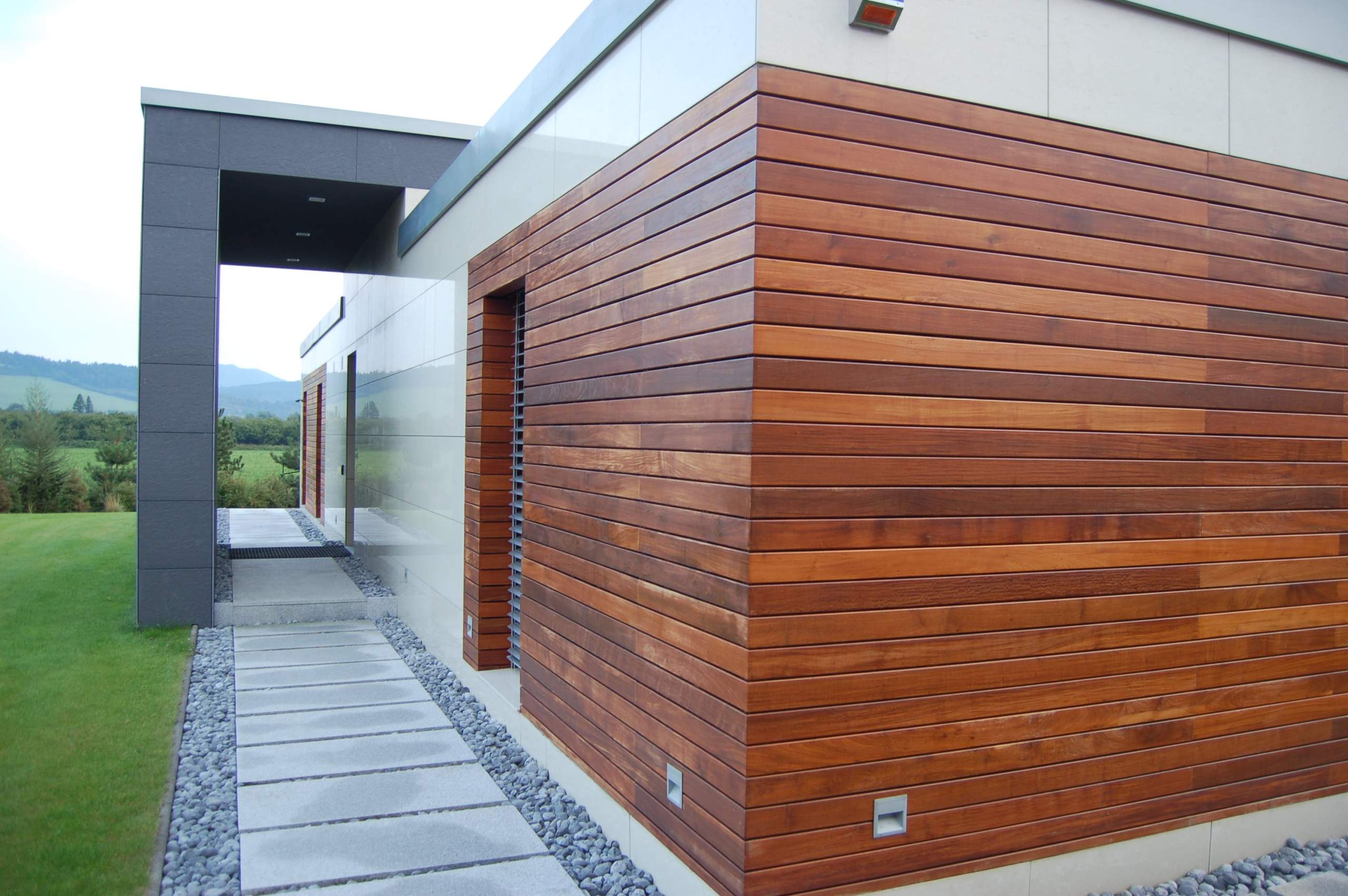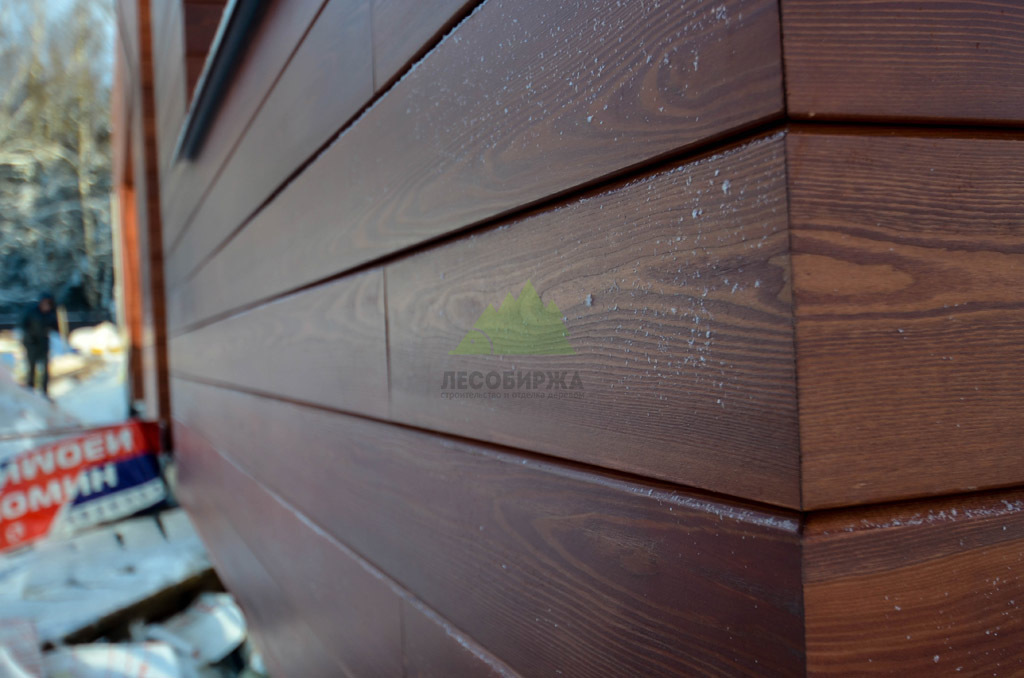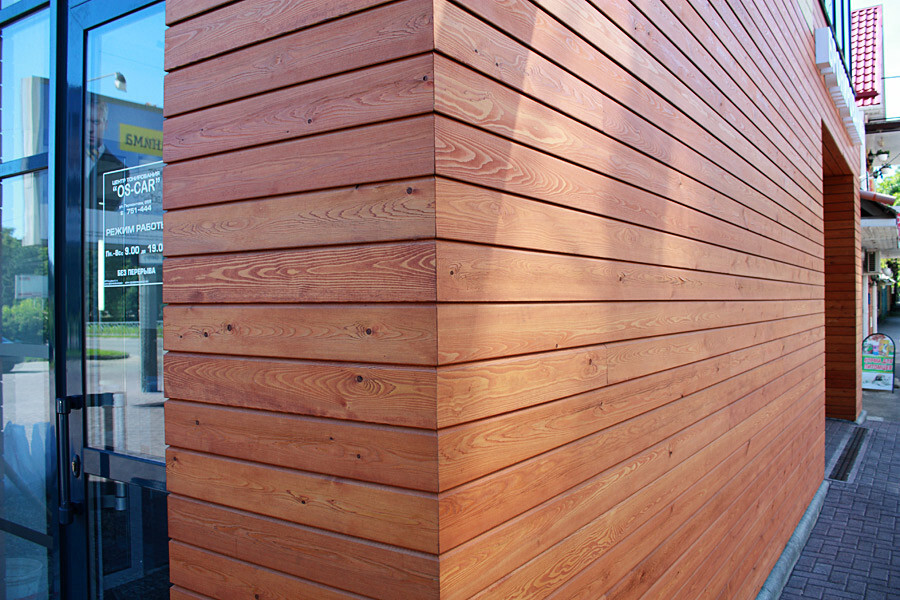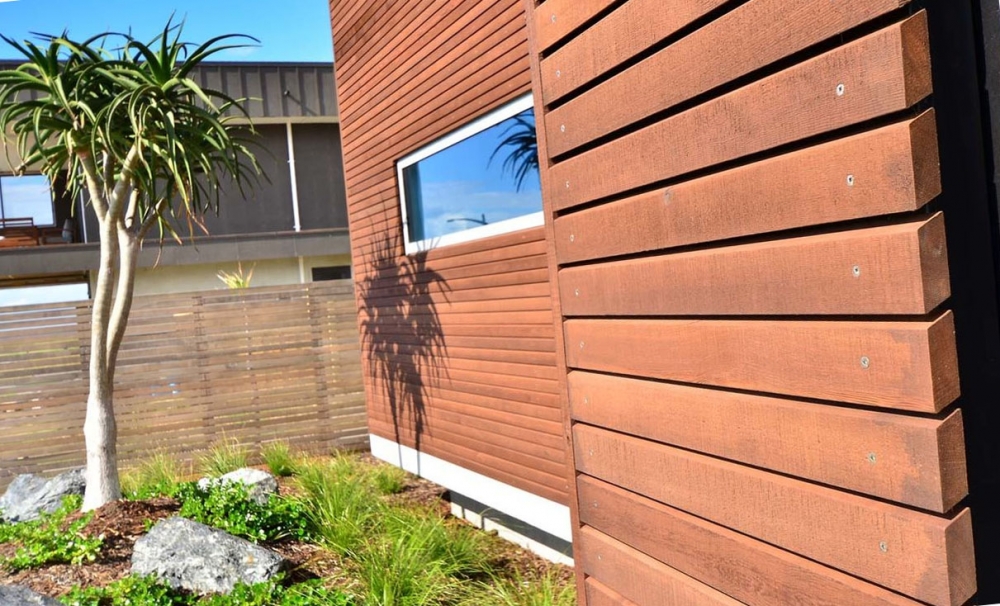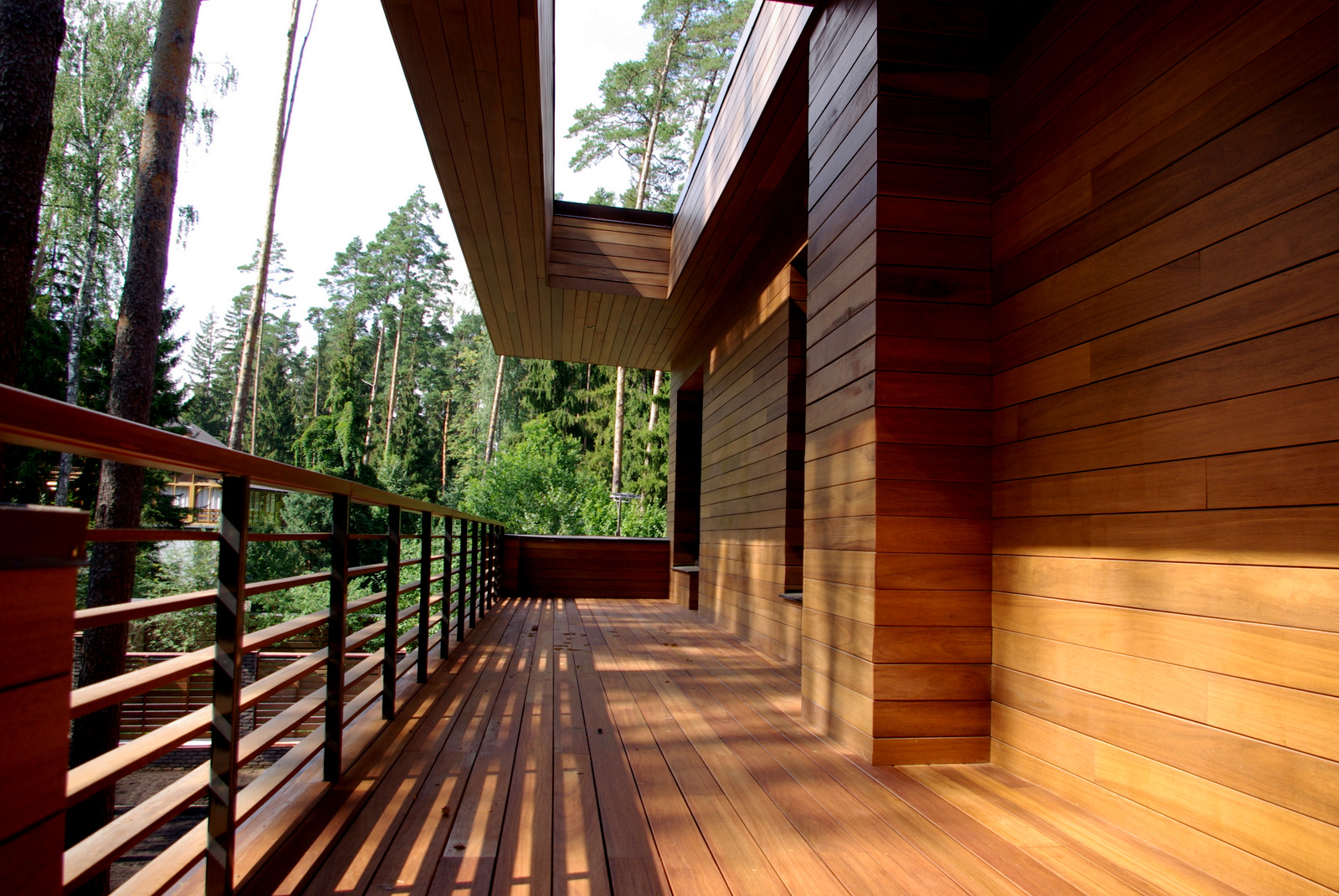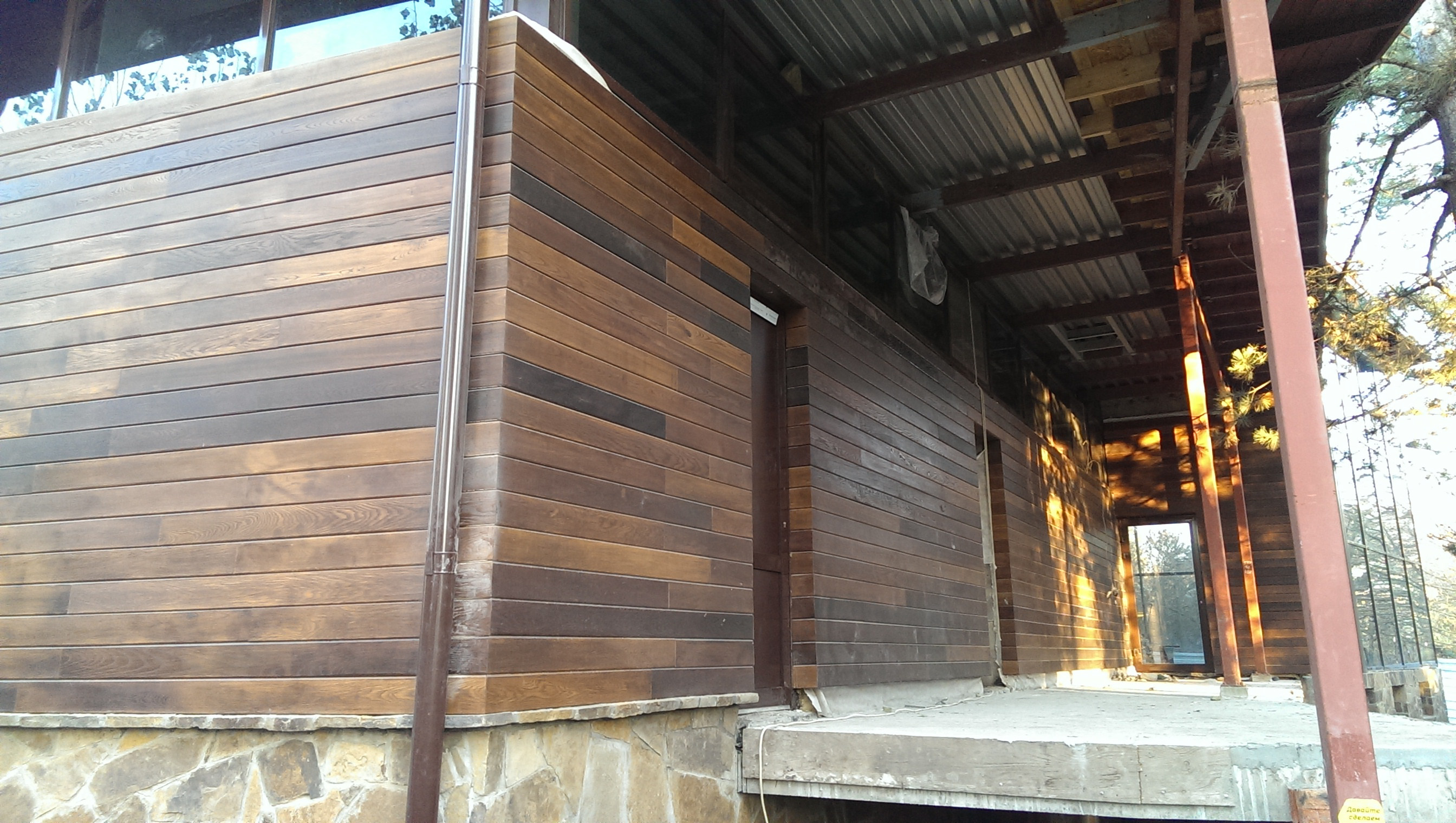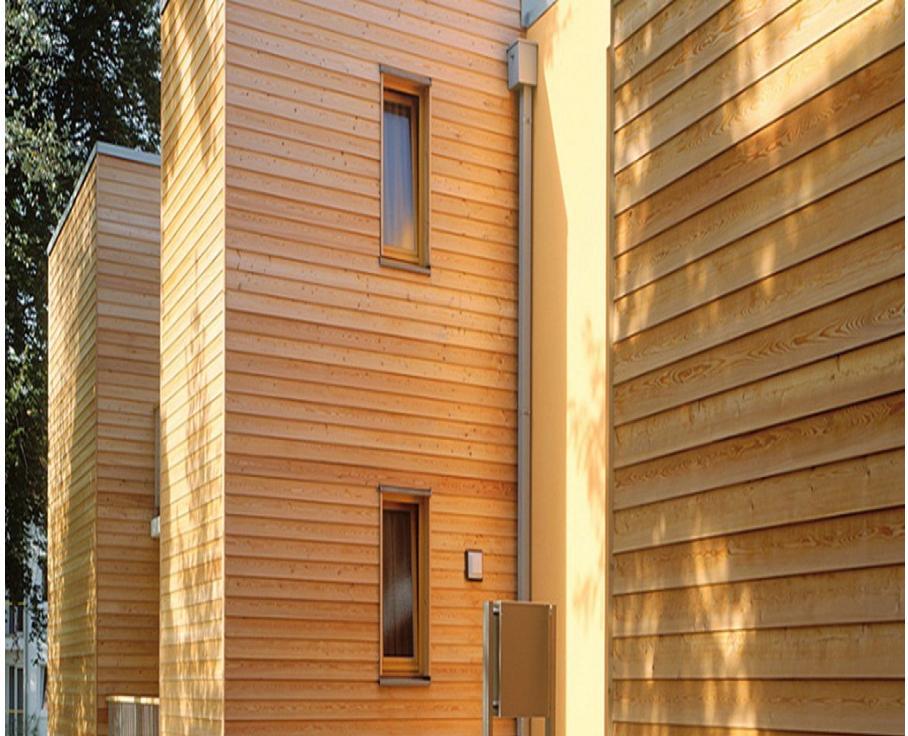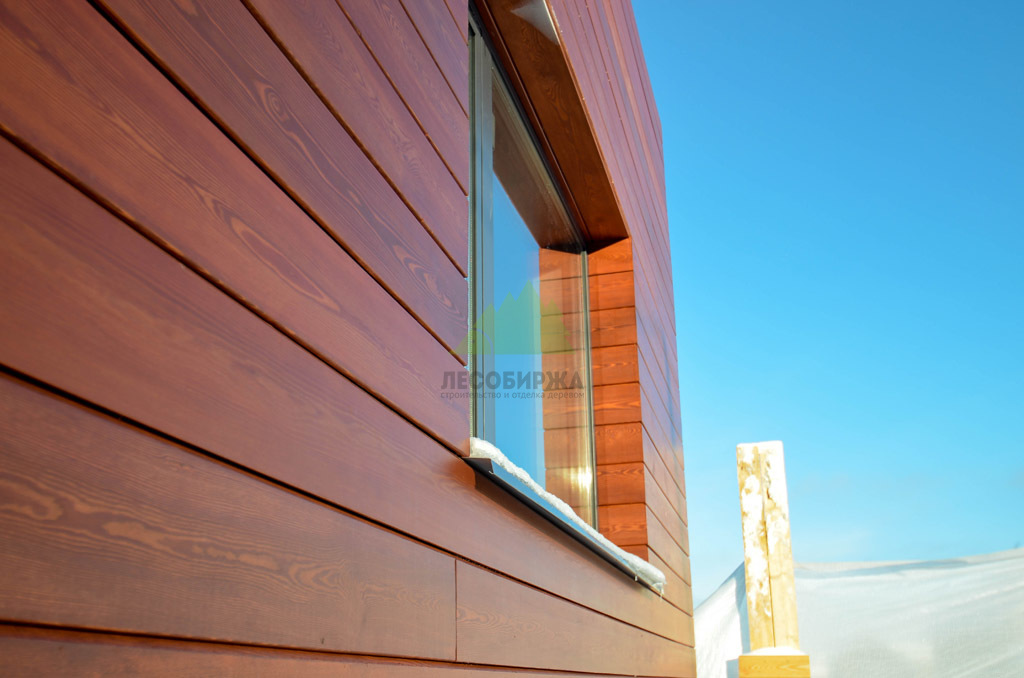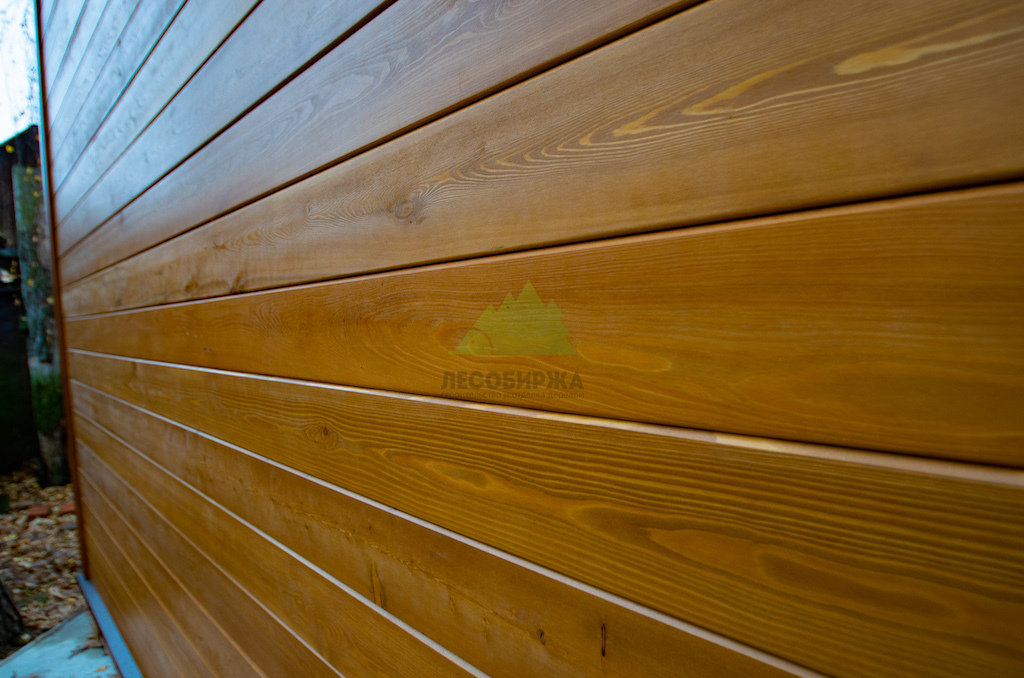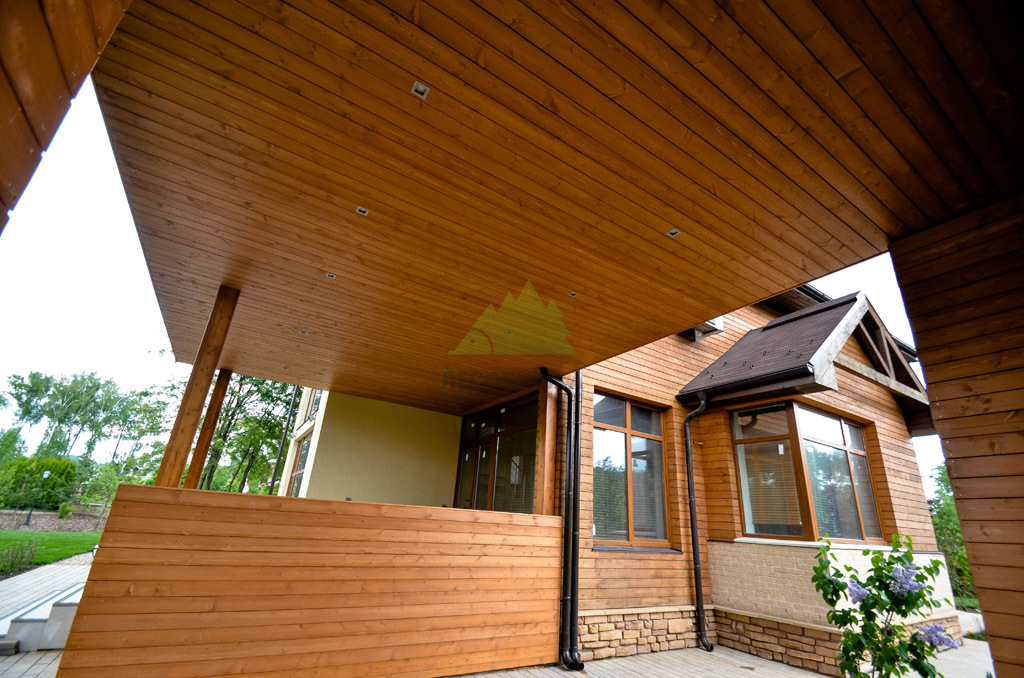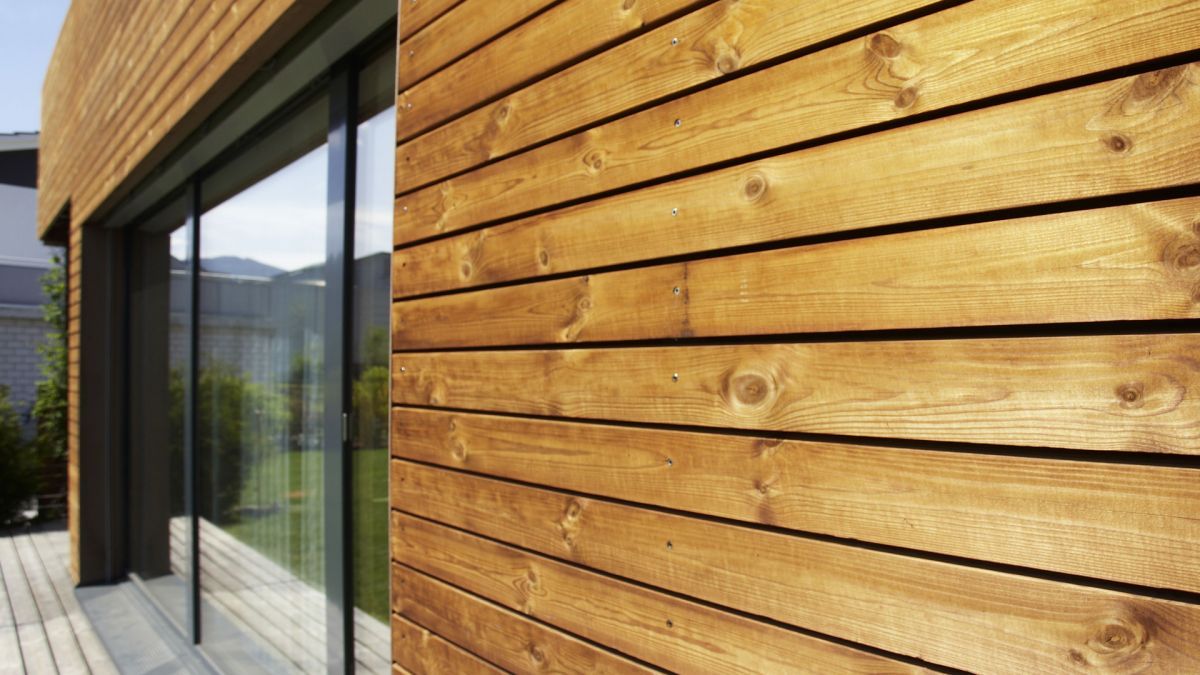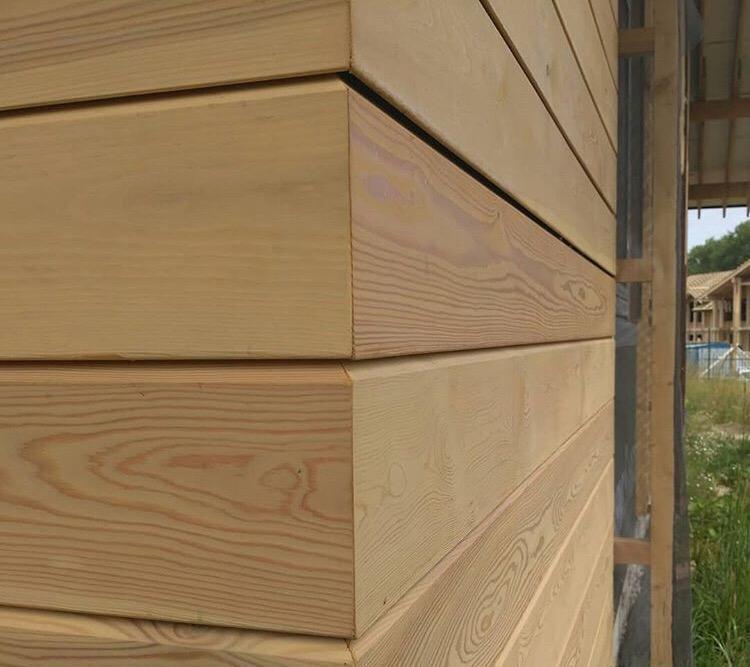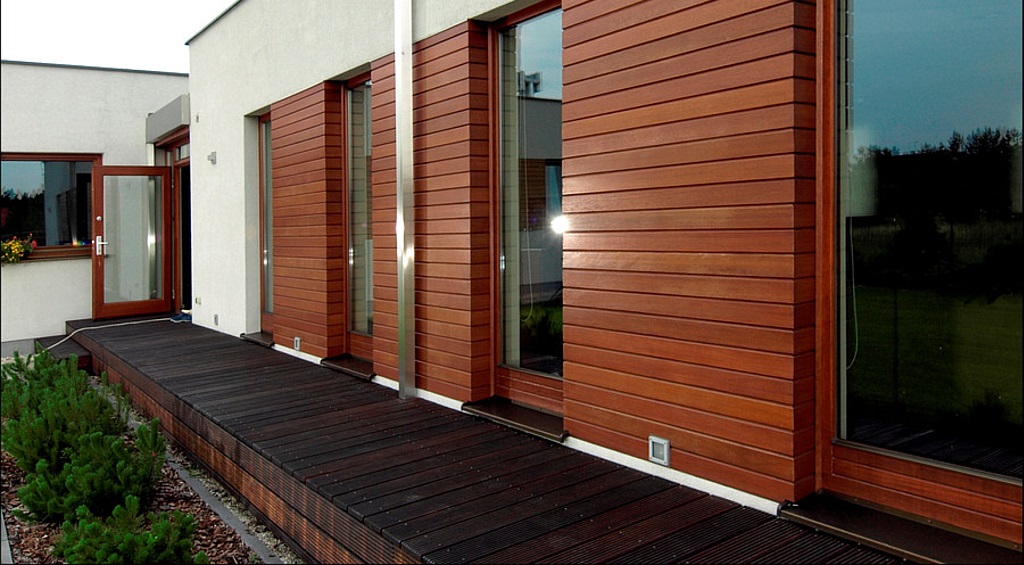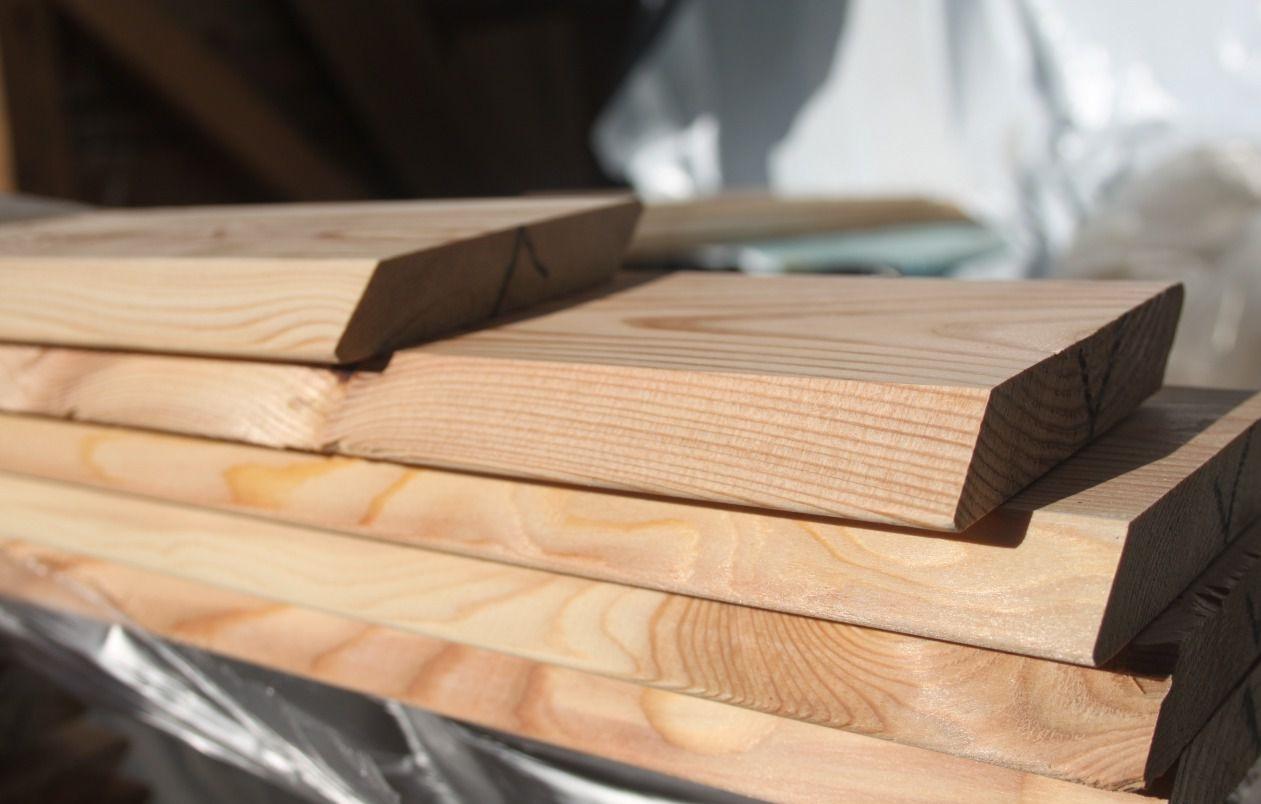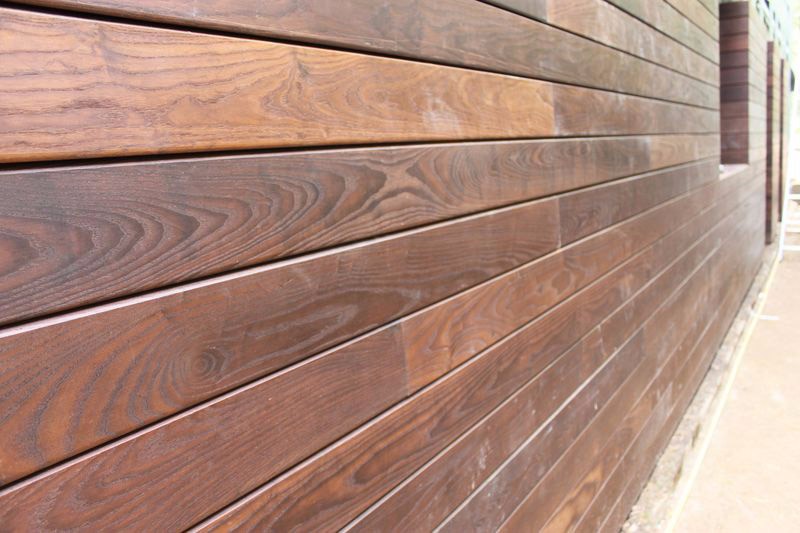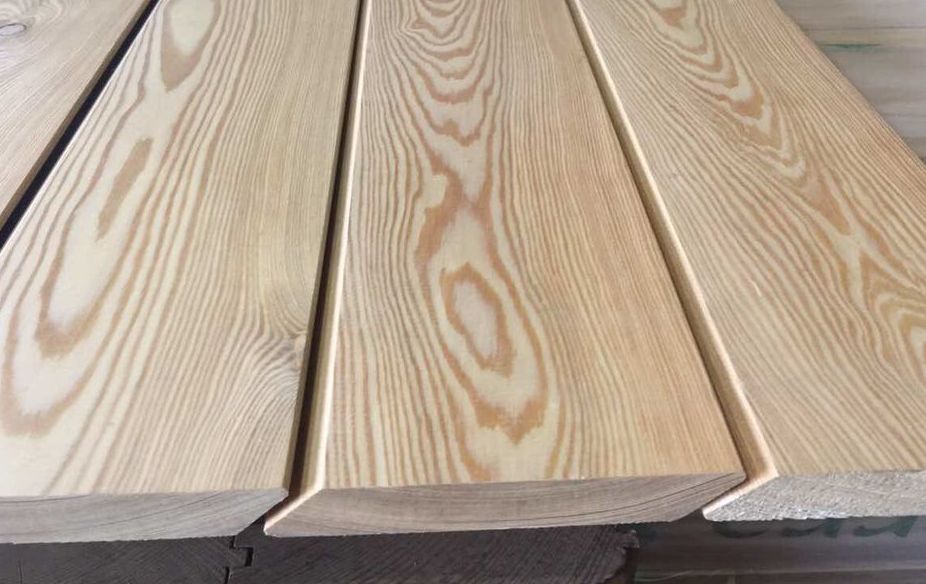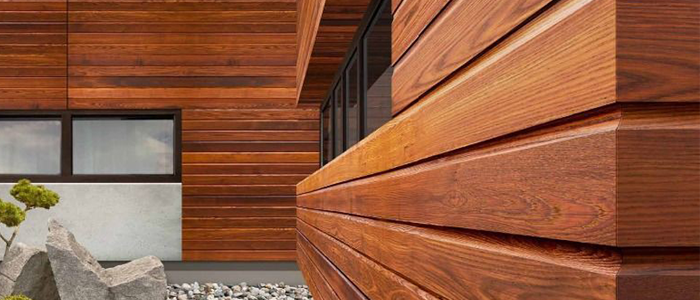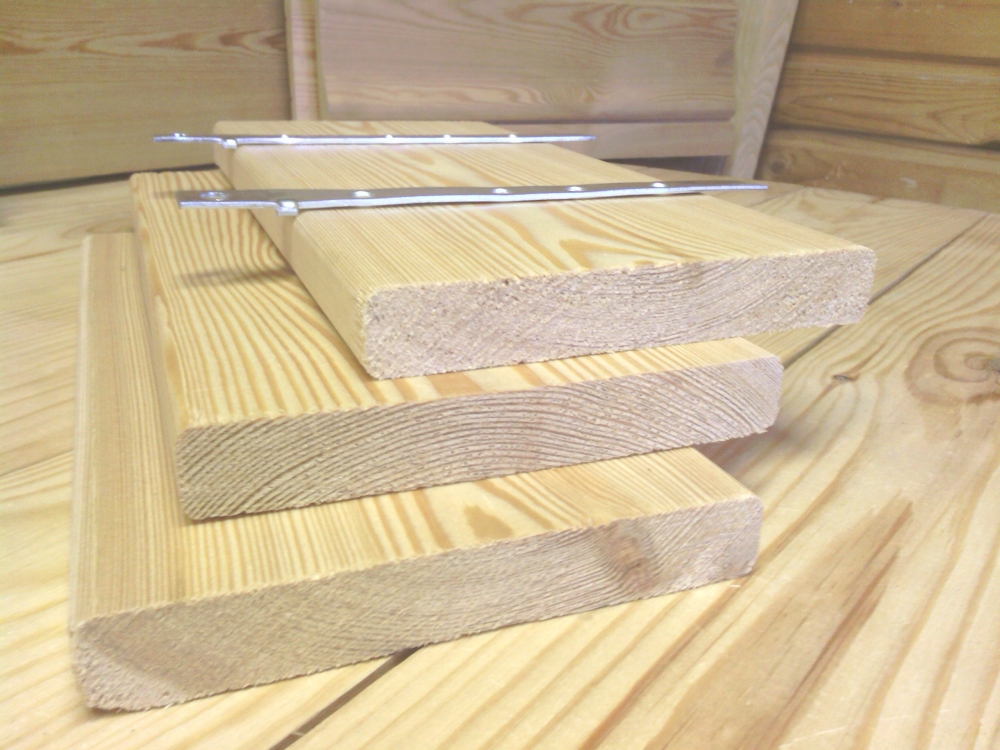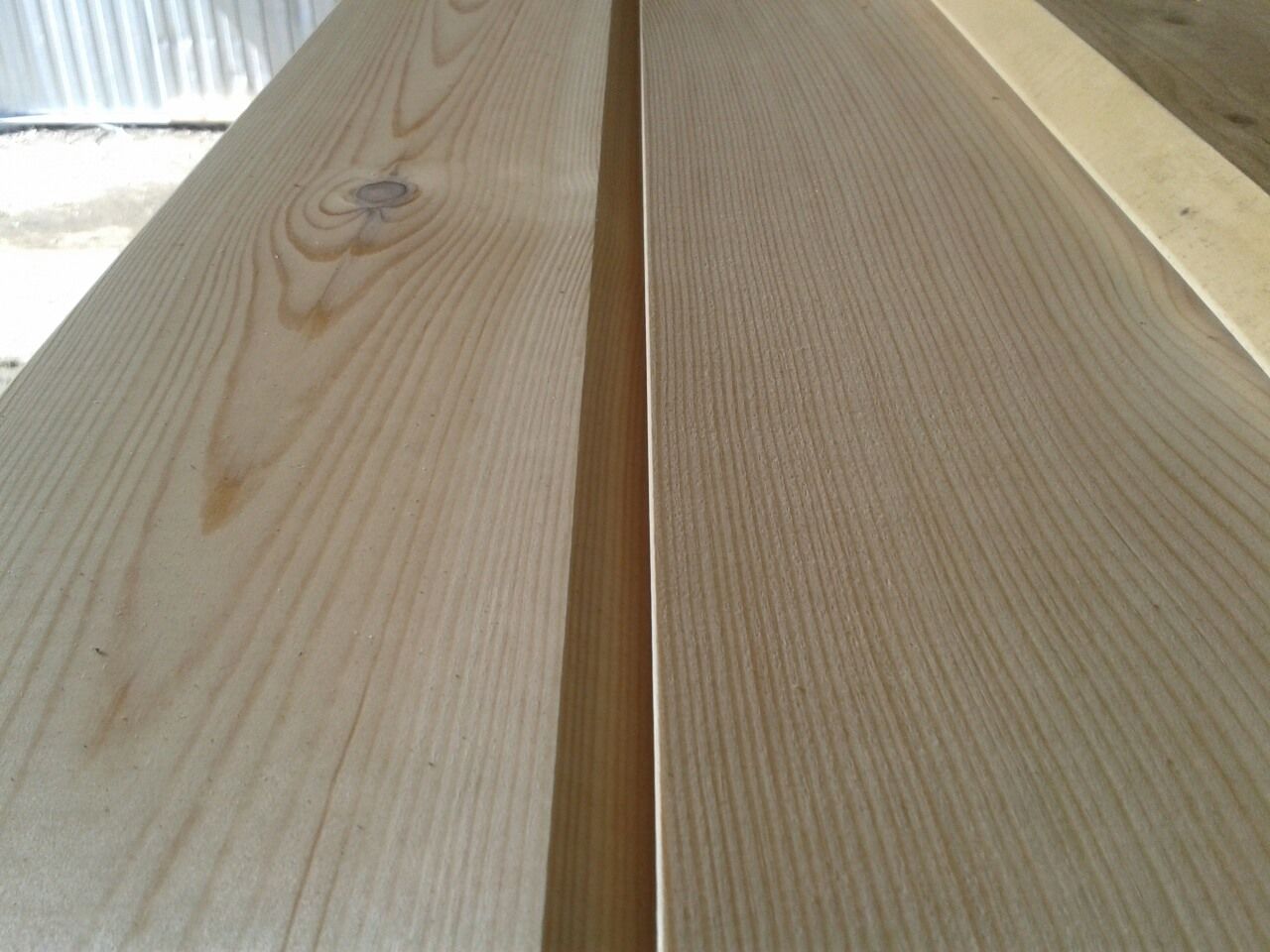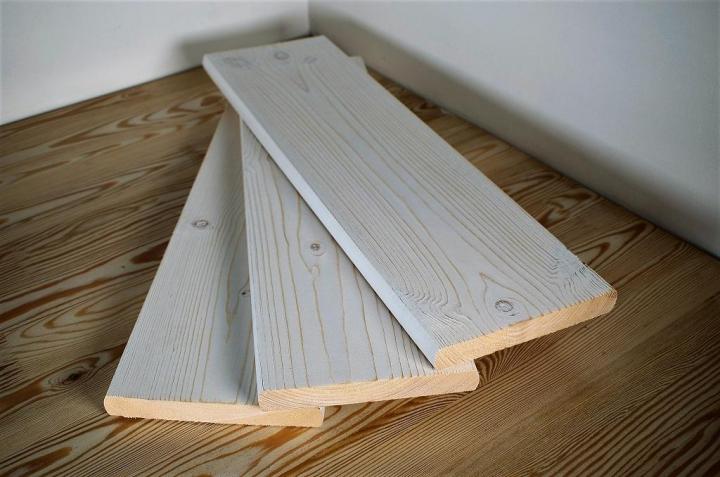Where is larch planken used?
Larch material, as well as oblique planken from pine, is often used for outdoor decoration. High quality indicators allow using such cladding to provide reliable protection and improve the appearance of the facade. In addition, straight and oblique planken (larch, oak, pine) can be used for interior decoration. Such decorative elements will not only decorate the room, but also create a cozy atmosphere thanks to the pleasant aroma of wood.
Also, straight and oblique larch planken is used in the construction of small architectural forms and additional structures:
- gazebos;
- baths and saunas;
- terraces;
- verandas;
- fences.
The elements can be used as decorative details inside the room; niches decorated with larch planken also look original in the interior. You can use the material when facing a loggia or balcony, as well as when repairing stairs and floors.
Facade finishing of a residential building
This is possible due to its high strength and the ability not to deform under heavy loads, since in the manufacture of such material as straight and oblique planken, larch is used, which has a high hardness.
Planken types
Planken is well recognized by its characteristic processing: the board is cut in a special way from all sides, depending on the profile obtained, the following types are distinguished:
- straight;
- straight with grooves;
- oblique.
A variation of the latter, which is also known as beveled, is a wedge-shaped plank with a characteristic overlap of the corresponding shape and tapering towards the edge. The length of the products ranges from 2000 mm or more with an average thickness of 20-24 mm and a width of 90 to 140 mm.
Any type of material can be used for the exterior decoration of the house, but due to the characteristic roundness, it will not work to ensure complete adherence of the elements to each other. In the event that a hinged facade is planned, then it must be borne in mind that not only rainwater will seep through small cracks, but also the frame of the sheathing will peep out.
Therefore, for finishing the facade, an oblique plank is more preferable, the installation of which is carried out with an overlap, which excludes the possibility of water getting under the cladding.
In addition, the surface of the façade takes on the appearance of a solid structure, since the connections are almost invisible.
And the usual, or classic, planken is suitable for the construction of decorative fences, gazebos, outdoor furniture and, of course, for interior decoration.
Pine and larch plank, classic and beveled. Video:
Classes and grade of planken
For many lumber, a specification is used, which depends on the quality of the raw materials used to make the products. For planken, this is also relevant, therefore, before asking about the price, you should clarify which class the manufacturer assigned to his products.
In general, the class does not affect the performance of the material, it is more about the aesthetic side of the products, since the class:
- "Extra" (or "Lux") - refers to products with an even color and no visible flaws: knots, resinous pockets, etc .;
- "Prima" - planken of the highest grade, but one small knot (no more than 10 mm) is already allowed per 1 meter of the length of the product;
- "A" - the number of knots and their size is increased, small blotches of color or a difference in shade are also possible;
- "B" - planken with uneven color, knots and resinous pockets.
Beautiful and practical material for facades
In fact, planken is a facade board, for the processing of which modern technologies and equipment are used, which ensures the high quality of this material.
In many of its properties, it is close to such finishing products as lining or block-house, but it is a fundamentally different product of the woodworking industry, which differs from its “relatives” both in appearance and in the way of installation.
In terms of strength characteristics, planken is very close to a deck or terrace board, it is highly resistant to negative natural factors, thanks to which it can be used not only for outdoor decoration, but also, for example, also for the construction of fences, gazebos and other structures in a suburban area.
Several types of wood are used for the production of planken, but the most popular are products from Siberian larch and pine, although on the market you can also find material for the manufacture of which exotic species were used.
Hardwood, for example, ash, is used less often, but only after special heat treatment, which provides the necessary strength. The most widely used material is made from larch, but planken from pine is also used, most often it is used for interior decoration.
In order to improve the performance characteristics, the wood undergoes a special heat treatment: planken obtained from thermowood acquires additional strength and becomes less vulnerable to the effects of natural moisture and microorganisms.
And, despite the fact that coniferous wood, due to the presence of resins, has a certain resistance to moisture, a special composition is applied as an additional protection of the material, which also pursues decorative and aesthetic functions, as it allows you to emphasize the beauty of the wood pattern.
But, if a material of a certain color is required for the embodiment of an architectural or design idea, then you can buy a dyed planken.
A separate type (or "competitor") of planken can be considered a wood-polymer composite (WPC), for the production of which wood chips and polymers are used. Differs in increased moisture and wear resistance and has dimensions similar to traditional planken.
Basic principles of planken mounting
Plankening can be performed vertically, horizontally and at an angle. The most convenient installation method is horizontal. It does not require special construction skills and special equipment from the master, and therefore there is a chance of its successful independent implementation. Houses sheathed with planken will keep warm and cozy for many years, and this requires a step-by-step adherence to the following technological points:
- Installation work, as when working with other cladding materials made of natural wood, begins with the sheathing of the wall surfaces of the building with harvested lags or larch bars. In any case, such parts must be treated with a special protective antiseptic. The elements are attached to the wall frame with long screws on top of a layer of insulation. The logs are finished with a finishing protective layer.
- For additional protection against moisture and mold, before installing the planken, it must also be opened with a layer of high-quality antiseptic. Each sawn-off end also needs to be covered with a protective layer.
- The length of the wooden plank depends on the size of the wall. Naturally, experts recommend refraining from cutting the board, but if the parameters of the wall do not make it possible to do without it, then no more than 3 boards can be stacked in one row, taking into account the obligatory separation. This moment is taken into account before the fastening of the lag begins.
- A feature of this technology is that the fastening of planks begins not from the 1st row, but from the 2nd. Using the usual building level (you can laser), the lags are marked according to the required dimensions. The bar will be attached to this marking.This will greatly facilitate the further process of installing the wall cladding.
- A board is applied to the bar, marking is made on it for future fasteners.
- The fasteners are located on the back of the planks in such a position that the hole for the self-tapping screw remains on top. At the bottom there is a solid part of the fastener, which starts behind the bar.
- The section from above is attached to the log with a screwdriver, and the lower part remains hooked to the bar.
- All subsequent rows of plankens are attached according to the same principle.
- When the wall is sheathed, it is necessary to remove the bar and fix the first row in its place.
- A mounting angle and a fastening element are fixed to the back plane of the 1st row of planks, which slides behind the boards of the 2nd row. At this time, the corner is screwed to the lag, from below.
There is also a modern and, in the opinion of most experts, a more reliable and faster way of fastening planks. There are no fundamental differences in the technology itself, the difference lies in the fastening element called "planfix". It is an L-shaped metal plate. With its help, you can finish the facade of the house with planken up to 25 millimeters thick.
A special feature of this mount is the presence of a special spike. Planfix refers to the type of hidden mounts, therefore, the most smooth and durable construction is obtained. Despite its novelty, planfix does not require the use of modern tools. Having a hammer in stock and observing the following steps, you can do it yourself:
- The lathing is made with wooden beams, which are located at a distance of 45-50 cm from each other.
- The 1st board is mounted to a wooden mounting frame with a self-tapping screw or an ordinary nail.
- Technologically correct installation implies combining the plane of the planfix with a bar of wooden lathing and the 1st board.
- All other planks that form the cladding are fixed in the same type, according to an understandable principle: the cladding material is tightly fixed on the wooden crate and sits on the planfix spike. This procedure is performed using a hammer and a backing that will soften the blows to the planks.
There is no doubt that houses sheathed with planken look especially impressive, since if you have the financial resources, you can mount custom planks with drawings previously applied to them. But the main thing to remember is that the success of cladding with such a peculiar board directly depends on the quality of the selected materials. Therefore, when buying plankens, be sure to ask the seller for a certificate of quality. If this is the case, then you can safely purchase this product.
Planken mounting methods
Fastening Snake - is a regular metal bar with holes for self-tapping screws
Beveled larch plank and other types of this finishing material can be fixed in two ways - closed and open.
A similar fastening can be done using the cross method - in this case, the strips will be installed “crosswise”.
Preparation for fastening the plank in a closed way begins with the layout of the boards on the ground or floor along the height of the wall that will be sheathed. After that, on the laid out surface, you need to transfer the dimensions of the crate, to which the boards will be attached.
When marking, do not leave small notches, but draw the full contours of each timber - this will significantly speed up the sheathing process and help not to get confused in various marks.
Metal strips are laid on an oblique larch plank in such a way that the former protrude beyond the edge of the latter, at least by a centimeter. After laying and fitting, the metal strips are fixed with at least two self-tapping screws.
For corner joints of the material, metal corners are used
The protruding ears of the crate will play the role of latches - the lower eye will be placed between the board and the timber, while the upper one is attached to the timber using a self-tapping screw. Actually, this is called the fastener for the planken "Snake".
For fixing the board with a groove, the "Crab" or "Bridge" mounts are used. These clamps are metal clamps that fix the facade board with clamping strips.
An open way of mounting a facade board is a simpler and more affordable solution. In this case, the boards will be fastened with self-tapping screws from the front side. This commit is much more reliable than the private method. In fact, no amount of natural influences will be able to tear off the coating attached in this way.
The material is fixed in the upper hole in the fastener
When finishing the house with planken, the corners of the structure are sheathed in the following sequence:
- fixing two boards with self-tapping screws at right angles;
- set the bonded boards at a corner.
Having carried out a high-quality finish with the considered cladding material, pay attention to its additional protection. A reasonable option would be to process the planken - the photo shows how the facade will look in its finished form
A variety of oils, varnishes and anti-rotting agents will provide additional protection, due to which the facade will last much longer.
Views
The modern market offers several varieties of planken, which depend on the type of wood, board geometry, mounting methods, beveled or straight configuration.
Beveled pine plank, also called oblique or rhombus, is considered universal. It is used in both interior and facade works. Visually, the end face resembles a parallelogram. The oblique view has no grooves or spikes, which does not allow it to be closed into a monolith, but this ensures a constant ventilation effect. A plank laid with an oblique cut down from the outside prevents water droplets from entering. From the side, the facade, made of rhombus, resembles solid wood.
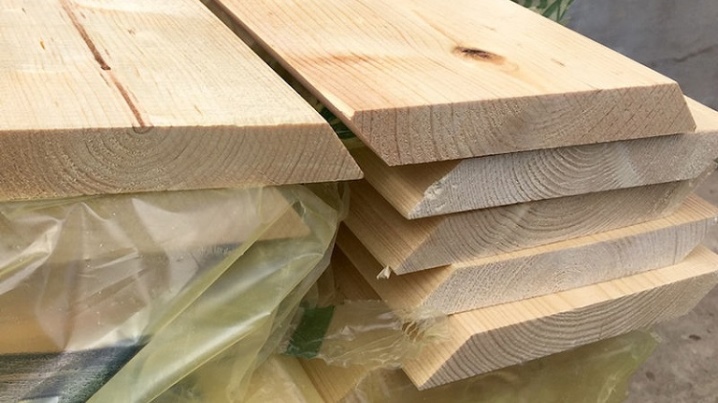

With its aesthetic appeal, the straight type has reduced performance. Uncovered joints of individual cladding elements quickly become clogged with dirt. Straight grooved plank more efficient and reliable. Such a solution creates surface protection against penetration of an aggressive environment.
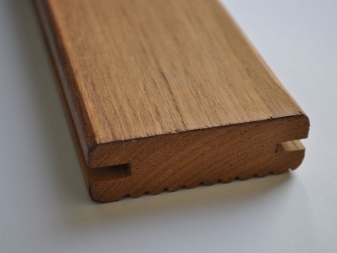

There are 5 grades of this finishing material in the price category.
- "Extra". Most often, the grade is used for interior decoration of residential and public premises. Virtually no flaws, the board is selected with the same external and technical characteristics.
- Prima. In this class, no more than two defects are permissible, indicated for the Extra variety. It is used in the decoration of non-residential premises, as well as baths, saunas, catering areas.
- "AB". This variety can be of any natural or mechanical type as long as it meets the requirements of DIN-68126. Used in outdoor work.
- "Sun". The same flaws are allowed as in the previous variety, but without any restrictions.
- "WITH". The lowest quality grade used for technical purposes only.


Features and scope
Larch plank is a finishing material in the form of thin boards with a sanded surface and a special edge treatment. Environmentally friendly natural wood is suitable for creating wall cladding, ceilings in the interior. Planken can be laid on the floor as a finishing coating instead of parquet boards, but the presence of irregularities and bevels at the edges should be taken into account. However, it looks most interesting of all when sheathing houses.
Such a facade board does not adhere tightly to the wall, providing a natural formation of the ventilation gap. A beautiful pattern of solid larch looks aesthetically pleasing and noble.
It is worth mentioning the main features of larch planken.
- Thermal resistance.Well-processed wood tolerates both winter frosts and direct heating by the rays of the sun without visible problems, retaining its properties and geometric parameters.
- Excellent strength characteristics. In the production of planken, only the densest part of the tree is used. Over time, the finish gains additional strength.
- Biological resistance. The material has the ability to resist the development of mold and mildew, it has enough resin to eliminate the need for antiseptic surface treatment.
- Increased moisture resistance. Wood does not absorb water, which allows it to resist rotting when finishing the surface of facades.


Varieties
Depending on the method of cutting the chamfers, there are 3 types:
- straight (mounted end-to-end while maintaining small gaps);
- beveled (parallelepiped-shaped, stacking is carried out end-to-end);
- straight line with pages (equipped with a special "crab" or "bridge" mount).
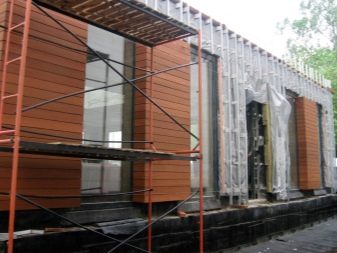


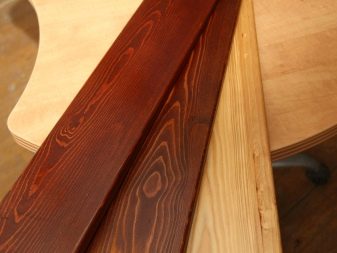
Depending on the type of material, there are:
- boards of the "Extra" class - are of the highest quality, do not have chips, damage and resin pockets on the surface;
- "Prima" products - small flaws and surface cracks are acceptable;
- board class "AB" - in addition to cracks, other flaws are found, for example, knots;
- "VS" boards - significant surface defects, the presence of knots, dark areas.
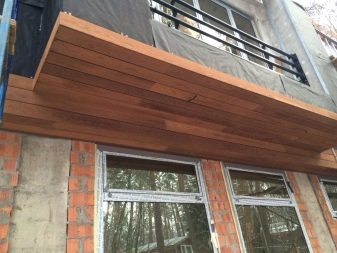

Planken can also vary depending on the material used. Larch products are widespread, which are characterized by the ability to tolerate high humidity well, while maintaining their parameters and geometry. Moreover, under the influence of moisture and high temperatures, they acquire additional strength and hardness.
This type of wood does not lend itself to attack by pests, which is why the finished board retains its integrity. The specified characteristics ensure durability, the service life of larch planken is 25 years.

They go well with other materials, be it parquet or artificial stone.
Canadian cedar and pine are also used for cladding. Strong, durable, with a characteristic pattern, the product becomes a worthy option for interior work and facade decoration.

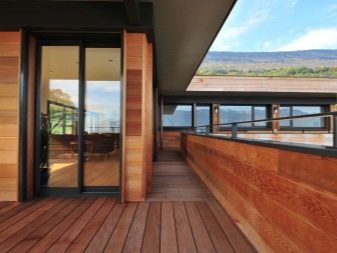
The version made of wood-polymer composite (WPC) has high performance characteristics. Its basis is made of pine wood, ground to crumb, which is filled with polymers. Thanks to this composition, it is possible to obtain a material that is completely not subject to decay, characterized by weather resistance, moisture resistance, and a long period of operation. WPC planken tolerates both high (up to + 70C) and low (up to -50C) temperatures, as well as thermal "jumps".

Finally, heat-treated planken is also isolated, which, thanks to a special treatment, has high biostability, is not subject to deformation and is characterized by lower weight.
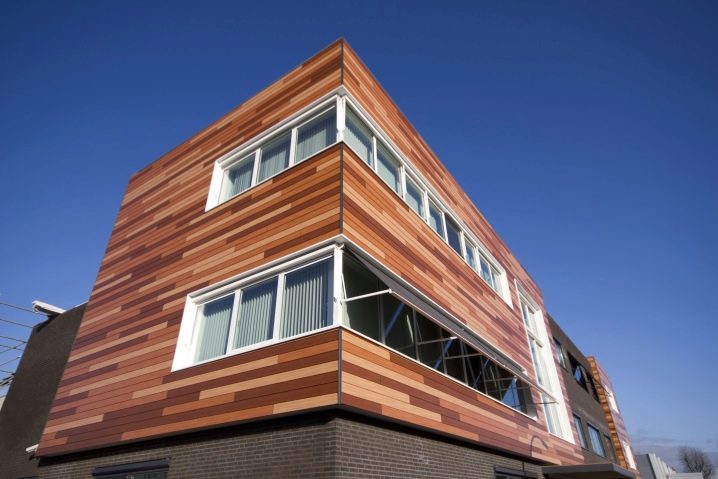
Peculiarities
A high quality board is used for the production of planken. The result is an elite finishing material in the form of planks, processed from all sides, including the sides and end sides. The boards have beveled and rounded side cuts. And although the planken is similar to the lining, there are significant differences between them.
- The plank board is water-repellent.
- The material does not have grooves, during installation it does not need a frame base, which allows you to carry out installation yourself, only after carefully studying the instructions.
- The simplicity of the design makes it easy to replace one board with another without disassembling the adjacent surface area. The panels are quickly assembled and do not need additional processing for many years.
- The planken finish is durable and durable.
- The pre-assembled panels have gaps between the surfaces, due to which there is constant ventilation to ensure that there is no condensation.The thickness of the planken varies from 1 to 2 cm, there are no standards for the length, but usually manufacturers offer material in lengths of 2 and 4 m.
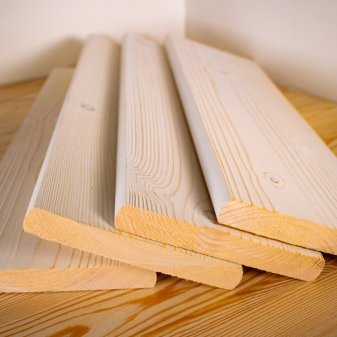

For facade cladding, planken is mainly used, made from autoclaved pine boards. Such thermally treated pine wood is collectively called thermosine. Angarskaya larch is especially popular as a raw material for planken production. Thermosine planken is considered to be an ideal finishing material for exterior finishing works, as the technology of heating the board in the steam chambers causes the resin in the upper layers of the wood to harden. As a result, the facing material will not release resin in hot weather in direct sunlight.
The use of pine in houses or apartments fills the room with a delicate coniferous aroma, creates a favorable microclimate and easy disinfection of the atmosphere. Oak panels are always prestigious, expensive, soundly and beautifully. The facade of such panels will not lose its representative appearance for decades. Linden, beech, dahoma and other trees have a peculiar pattern and aroma.
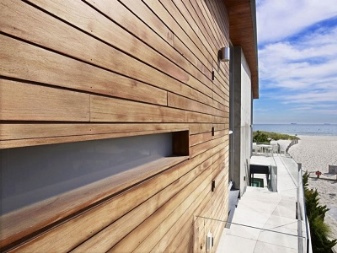

The advantages of planken should be outlined.
- The processing of boards takes place on the automated lines of the woodworking industry. Quality and accuracy control is ensured in intermediate areas.
- A board made of wood of certain species is processed in full compliance with the specified technical characteristics. In the process of production and constant control, material is rejected even with small deviations from the required parameters.
- During production, sapwood, knots and other imperfections are removed from the wood. The rich tint and texture palette makes it possible to combine planken with surfaces and materials of different quality.
The production processing of the material technologically ensures the appearance of the finest gaps between the surfaces during installation, as a result of which natural ventilation is formed. This guarantees the safety of the heat-insulating layer between the wall and the facade, since breathable panels do not allow condensation to form and rotting.


Mounting
Before proceeding with the installation of facade boards, they prepare the crate. Larch logs are impregnated with an antiseptic, fixed on the walls over a layer of insulation with screws or self-tapping screws. Lags are attached at a distance apart 1 meter. The location of the lag is perpendicular to the direction of the facade coating. If the board is cut off, then its ends are also covered with an antiseptic, like everything else. If the facade is planned to be painted, then the outer side is not covered with the composition, since this will damage the high-quality painting.
The second row of planken is laid first. This is done for the purpose of further convenience in work - a rail is attached in place of the first row. The position of the rail must be checked with a laser or water level - the board must be strictly horizontal (unless, of course, a different arrangement is conceived according to the project). The starting rail is then removed and the first row is mounted in its place.
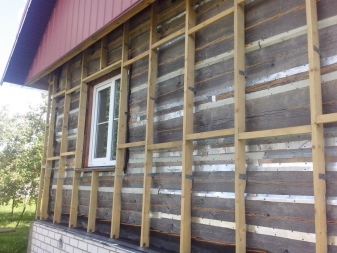

The end ends are cut at right angles, and the corner ends are cut at 45 degrees. The fasteners should be mounted on the back - to the right and left of the center line. Plastic devices are installed between the rows of boards to adjust the width of the required gap, since the board can expand over time. As the installation progresses, the fixtures are released and used for the next rows. The third and subsequent rows are mounted in the same way.
To simplify control, several marks are applied to the crate along the entire height. After the second row and the rows above are secured, the starter bar is removed and the first row is installed. To do this, the plank is inserted into the vacant space, the upper fasteners move under the second row, and the lower one is fixed with self-tapping screws.In this way, the cladding is continued along the entire facade.
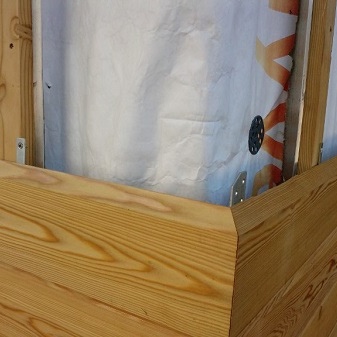

For information on the advantages of planken from needles, see the next video.
Characteristics of larch planken
Planken or imitation of a bar can be made from various materials. Depending on the raw materials used, the characteristics and appearance of the boards will differ. One of the most popular is larch planken. Its quality characteristics have made the finishing material very popular:
- High strength and reliability. The hardest part of the tree is used for manufacturing. The finish becomes even stronger with extended use.
- Resistant to mold and mildew, as larch has a high resin and gum content. There is no need to apply an antiseptic treatment, but coating with special compounds will extend the life of the finish.
- Excellent moisture resistance, so that the tree does not rot when exposed to atmospheric precipitation.
- It tolerates low temperatures well, and also does not deteriorate in direct sunlight.
As for the parameters of the material, they can vary:
- length - from 2 to 4 m;
- width - from 9 to 14 cm;
- thickness - 2 cm.
Such dimensions greatly simplify and speed up the installation process. The appearance of the material also differs depending on the type selected.
Varieties of larch planken
There are several types of larch planken, each of which has visual features. It may also differ in the type of attachment.
p> In addition, the material is divided into categories according to its quality:
- planken Extra have no defects, surface without knots;
- Prima A provides for one knot per running meter;
- AB can have a certain number of knots, but they are small in size;
- C - the lowest quality grade, economy class, where there are noticeable defects, which makes it rational to use it for fences and barriers, but not for the facade.

